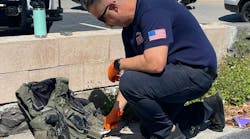Let’s put some epidemics in perspective. In 2014 there was a very real Ebola scare in this country; one man died of this virus and three others were infected. Currently we are being vigilant about Measles (one death since 2003) and Middle East Respiratory Syndrome (MERS) – 2 cases in the USA/no deaths. However, there are a couple of epidemics that don’t get nearly as much attention as they deserve: Heroin overdoses and Hepatitis C. Yes, they overlap. Yes, they are preventable. The incidence of both has tripled in the past few years. And now, police officers are more responsible than ever before.
- The death rate from heroin overdoses in the United States nearly tripled between 2010 and 2013. The death rate grew from 1 for every 100,000 people in 2010 to 2.7 for every 100,000 in 2013.
- There were 8,257 heroin overdose deaths in 2013(latest year for statistics).
- The death rate for men was nearly four times as high as it was for women.
- Younger white males replaced middle-aged and older black men as the most common victims of the epidemic.
- The Midwest passed the Northeast and the West as the region with the highest death rate.
- Opioid withdrawal reactions are very uncomfortable but are not life-threatening. Symptoms usually start within 12 hours of last heroin usage and within 30 hours of last methadone exposure.
4.2 million Americans over the age of 11 have tried heroin at least once, according to the National Institute on Drug Abuse. Almost half of young people who use heroin today started with prescription opioids. An estimated 23% of them will become addicts; and it is addicts who die more frequently than new users studies show. Today's typical heroin addict starts using at 23, is more likely to live in the affluent suburbs and was likely unwittingly led to heroin through painkillers prescribed by his or her doctor.
The sharp increase in heroin deaths coincided with curbs on abuse of opioid analgesics (Percocet, Vicodin) established at about the same time. When authorities cracked down on pill mills and required the reformulation of the prescription medications it made it more difficult to use prescription opiods recreationally. The comparable cheaper price of heroin increased its popularity. Opiate pain medications cost the uninsured about $1 per milligram, so a 60-milligram pill will cost $60. You can obtain the equivalent amount of heroin for about one-tenth the price.
So, what are we, as a society, supposed to do when our children, our parents, and loved ones, are unable or unwilling to get off of heroin? The grief caused by a heroin overdose death is immeasurable. The loss of family is heartbreaking. According to the Surgeon General the estimated economic cost of illegal drug abuse is $181 billion per year. Jails and prisons are overfilled related to illegal drug offenses. But unfortunately, this is just where two other significant epidemics begin. Heroin abuse is overwhelmingly correlated with two deadly diseases; Hepatitis C and Human Immunodeficiency Virus (HIV). The common connection here is sharing dirty (contaminated) needles.
According to the CDC new cases of hepatitis C have more than tripled in recent years. In 2013 there were 2,138 new cases reported….but the actual number is MUCH higher; the CDC believes the actual number of new hepatitis C cases is about 14 times the number of reported cases in any given year. An estimated 5 million persons have chronic hepatitis C virus infection in this country alone. On average, people with HCV die 15 years earlier than the general population.
The Four Steps of Harm Reduction
Harm reduction is a set of practical strategies and ideas aimed at reducing negative consequences associated with drug use. Harm reduction programs have been shown to lower HIV risk and hepatitis transmission, prevent overdose, and provide a gateway to drug treatment programs for drug users by offering information and assistance in a non-judgmental manner. Harm Reduction is also a movement for social justice built on a belief in, and respect for, the rights of people who use drugs.
#1 - Needle Exchange Programs
I know that giving drug users clean needles for free might seem counterintuitive. However, research by the U.S. Centers for Disease Control and Prevention indicates that syringe exchange programs in no way lead to an increase in drug use. The CDC reports that offering addicts help when they go in for a clean needle will result in more people starting down the road to recovery. Additionally clean syringes help prevent the spread of infectious diseases like HIV and Hep C. One-third of all AIDS cases in the U.S. have been caused by syringe sharing: 354,000 people. Without a needle exchange program an estimated 1/3rd of heroin users will contract Hep C.
U.S. federal government support for syringe access programs: $0.00; thanks to a federal ban reinstated by Congress in 2011 that prohibits any federal assistance for them. Fortunately, cities and communities nationwide have implemented their own needle exchange programs. We need to get real here people – it costs only a dime for a needle versus $90,000 for three months of hepatitis C treatments. Quite simply there is no comparison.
Thankfully, cities and communities have recognized the need for a needle exchange program, and these services are being added every day. On July 2nd West Virginia state and local officials announced a year-long pilot syringe exchange program in Cabell County Thursday that could, if found successful, become a precursor program for counties throughout the state.
These programs provide free, non-judgmental health services to drug users in addition to clean needles/syringes, thus drawing the drug-using community into a health care space that could eventually lead to treatment and recovery programs.
#2 Police training programs on the heroin rescue drug Naloxone (Narcan)
How many times have you beat the FD and EMTs to a heroin overdose scene?; it is pretty common. Police are often the first to arrive at the scene, and experts say those early minutes can be the key to saving a life. And even if the ambulance arrives first they may have to stage until you determine that it is safe for them to make contact. In New York City, 420 people died of heroin overdoses in 2013, the highest number of overdose fatalities from the drug in a decade, the New York Times reported. In fact, heroin deaths outpaced murders in New York for the second straight year in 2014. In response to the epidemic, the NYPD launched a pilot program in one precinct in each borough in the fall of 2013, training officers to administer nasal naloxone. New York currently has over 212 departments carrying naloxone. To their credit, NYPD officers have made 212 heroin overdose reversals. Currently over 350 US law enforcement departments carry naloxone.
FAQ
- What happens in a heroin overdose? An overdose of heroin or other opiates such as oxycodone or hydrocodone can depress breathing and leave the user unconscious. Untreated, the user can die.
- How does Naloxone work? Naloxone binds to the opioid receptors in the brain, displacing other drugs and reversing the effects.
- How is Naloxone delivered? Naloxone can be administered by injection into a muscle or as a nasal spray and lasts 30 to 90 minutes. The individual should still seek emergency treatment once (s)he is revived. Naloxone will not reverse the effects of other types of drugs, such as cocaine or methamphetamine.
- What are the risks of using Naloxone? There are absolutely none. If you were to squirt it up your nose right now, nothing would happen. There is zero risk.
- Can civilians carry Naloxone in case of an overdose? Families of addicts are now carrying Narcan and so are active users; actually it is encouraged. It is suggested that education and distribution of Narcan should take place in detox facilities and treatment centers. 80% of addicts who leave detox without further treatment will relapse and many of them overdose because their tolerance has dropped.
Right now, Narcan costs between $20- $40 per dose; these costs are often covered by state funding and other grants.
#3 Anti-addiction medication: Suboxone
Suboxone, a drug that blocks the effects of heroin withdrawal and curbs cravings, is the most effective treatment for heroin and opioid addiction. Suboxone can be particularly instrumental in preventing the relapses that are common in the weeks following rehabilitation. These relapses make drug users particularly vulnerable to overdose, since they have a lower drug tolerance after treatment. Additionally, unlike Methadone, individuals do not need to go to a city clinic for help. Unfortunately, there are current prescribing limits related to Suboxone, but those limits are currently being challenged.
#4 Adopt Good Samaritan laws related to heroin overdose
The Good News: According to the Drug Policy Alliance, most deaths occur between one and three hours after an overdose, and immediate calls for medical help greatly reduce a person's chance of permanent physical damage or death. The Bad News: Many people who witness an overdose fear arrest or punishment -- and as a result, they don't call for help. Good Samaritan laws provide limited immunity from drug prosecution for individuals who call 911 or otherwise provide help to an overdose victim. As of June 2015, 28 states had Good Samaritan protections on the books, seven of which were passed this year.
At least we have a start, actually a pretty good start. This epidemic almost took the life of someone who I love very much this year. She now has a second chance. If we work together there are whole a lot of second changes to be given. To all of the officers who have made a difference in this epidemic, please know that you are true heroes.


